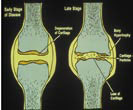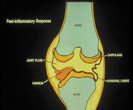
Arthritis

Osteoarthritis
Joint Degeneration 
Rheumatoid Arthritis
Inflammed lining destroying cartilage |
Arthritis is too often thought of as a disease that strictly affects older Canadians, and those with a lifetime of wear and tear on their joints. However, arthritis acts through different mechanisms, and there are other characteristics, causes, co-existing conditions, and various treatments.
Osteoarthritis (OA) is a chronic, typically slow- progression disorder causing degeneration of the cartilage and nearby bone, and results in joint pain and stiffness. It affects 10% of Canadians, men and women about equally. OA may have no known cause, or be an outcome of another disease, an infection, injury, or overuse. Of interest is that it disproportionately affects those who repetitively stress their joints (e.g., miners), but long distance runners are at no greater risk. The hip, knee, hand and spine are most commonly affected by osteoarthritis. Treatment is through exercise, physical therapy (often with heat), analgesics, anti-inflammatory drugs, local injection of corticosteroids, and finally, surgery (hip and knee joint replacement).
Rheumatoid Arthritis (RA) is a chronic, progressive autoimmune disease that inflames joints, causing swelling, pain, often disfigurement and eventual destruction of the cartilage, bone, and ligaments. The cause is not known, but heredity appears to be a factor. It is 2-3 times more common in women until the fifth decade of life. RA affects almost 1% of Canadians, usually between ages 30 and 40. Without therapy between 10% and 50% will become disabled and unable to work, and depression is common. Treatment is through rest, anti-inflammatory drugs, gold injections, corticosteroids, methotrexate, and biologic therapies for moderate and severe cases.
While there are many painful facts and figures about arthritis, there is also significant research activity, and enough ‘good news stories’ to give real hope.
Sources: Facts from Statistics Canada (SC), the Public Health Agency of Canada (PHAC), the Canadian Institute for Health Information (CIHI), the Institute for Work & Health (IWH), the Arthritis Society (AS), Health Canada, and the health ministry websites for BC, AB, and ON.
|
Categories: Disease Management
